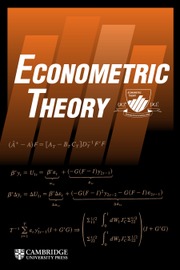Crossref Citations
This article has been cited by the following publications. This list is generated based on data provided by
Crossref.
Kristensen, Dennis
and
Shin, Yongseok
2005.
Estimation of Dynamic Models with Nonparametric Simulated Maximum Likelihood.
SSRN Electronic Journal,
CORRADI, VALENTINA
and
DISTASO, WALTER
2006.
Semi-Parametric Comparison of Stochastic Volatility Models using Realized Measures.
Review of Economic Studies,
Vol. 73,
Issue. 3,
p.
635.
FERNÁNDEZ-VILLAVERDE, JESÚS
and
RUBIO-RAMÍREZ, JUAN F.
2007.
Estimating Macroeconomic Models: A Likelihood Approach.
Review of Economic Studies,
Vol. 74,
Issue. 4,
p.
1059.
Carrasco, Marine
Chernov, Mikhail
Florens, Jean-Pierre
and
Ghysels, Eric
2007.
Efficient estimation of general dynamic models with a continuum of moment conditions.
Journal of Econometrics,
Vol. 140,
Issue. 2,
p.
529.
Kristensen, Dennis
and
Shin, Yongseok
2008.
Estimation of Dynamic Models with Nonparametric Simulated Maximum Likelihood.
SSRN Electronic Journal,
Kristensen, Dennis
2008.
Uniform Convergence Rates of Kernel Estimators with Heterogenous, Dependent Data.
SSRN Electronic Journal,
Creel, Michael
and
Kristensen, Dennis
2009.
Estimation of Dynamic Latent Variable Models Using Simulated Nonparametric Moments.
SSRN Electronic Journal,
Corradi, Valentina
and
Swanson, Norman R.
2009.
Predictive Density Construction and Accuracy Testing with Multiple Possibly Misspecified Diffusion Models.
SSRN Electronic Journal,
Kristensen, Dennis
2009.
UNIFORM CONVERGENCE RATES OF KERNEL ESTIMATORS WITH HETEROGENEOUS DEPENDENT DATA.
Econometric Theory,
Vol. 25,
Issue. 5,
p.
1433.
ALTISSIMO, FILIPPO
and
MELE, ANTONIO
2009.
Simulated Non-Parametric Estimation of Dynamic Models.
Review of Economic Studies,
Vol. 76,
Issue. 2,
p.
413.
Nickl, R.
and
Pötscher, B. M.
2010.
Efficient simulation-based minimum distance estimation and indirect inference.
Mathematical Methods of Statistics,
Vol. 19,
Issue. 4,
p.
327.
Fernández-Villaverde, Jesús
Guerron-Quintana, Pablo
and
Rubio-Ramirez, Juan Francisco
2010.
Fortune or Virtue: Time-Variant Volatilities Versus Parameter Drifting in U.S. Data.
SSRN Electronic Journal,
Fernández-Villaverde, Jesús
Guerron-Quintana, Pablo
and
Rubio-Ramirez, Juan Francisco
2010.
Fortune or Virtue: Time-Variant Volatilities Versus Parameter Drifting in U.S. Data.
SSRN Electronic Journal,
van Binsbergen, Jules H.
Fernández-Villaverde, Jesús
Koijen, Ralph S. J.
and
Rubio-Ramirez, Juan Francisco
2011.
The Term Structure of Interest Rates in a DSGE Model with Recursive Preferences.
SSRN Electronic Journal,
Cai, Lili
and
Swanson, Norman R.
2011.
In- and out-of-sample specification analysis of spot rate models: Further evidence for the period 1982–2008.
Journal of Empirical Finance,
Vol. 18,
Issue. 4,
p.
743.
Corradi, Valentina
and
Swanson, Norman R.
2011.
Predictive density construction and accuracy testing with multiple possibly misspecified diffusion models.
Journal of Econometrics,
Vol. 161,
Issue. 2,
p.
304.
Swanson, Norman R.
and
Cai, Lili
2011.
In- and Out-of-Sample Specification Analysis of Spot Rate Models: Further Evidence for the Period 1982-2008.
SSRN Electronic Journal,
Gach, F.
and
Pötscher, B. M.
2011.
Nonparametric maximum likelihood density estimation and simulation-based minimum distance estimators.
Mathematical Methods of Statistics,
Vol. 20,
Issue. 4,
p.
288.
Creel, Michael
and
Kristensen, Dennis
2012.
Estimation of dynamic latent variable models using simulated non‐parametric moments.
The Econometrics Journal,
Vol. 15,
Issue. 3,
p.
490.
Kristensen, Dennis
and
Shin, Yongseok
2012.
Estimation of dynamic models with nonparametric simulated maximum likelihood.
Journal of Econometrics,
Vol. 167,
Issue. 1,
p.
76.

